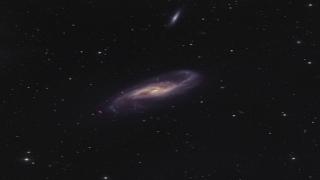Bibcode
Rautio, R. P. V.; Watkins, A. E.; Salo, H.; Venhola, A.; Knapen, J. H.; Comerón, S.
Referencia bibliográfica
Astronomy and Astrophysics
Fecha de publicación:
1
2024
Revista
Número de citas
4
Número de citas referidas
4
Descripción
Context. The universality or non-universality of the initial mass function (IMF) has significant implications for determining star formation rates and star formation histories from photometric properties of stellar populations.
Aims: We reexamine whether the IMF is deficient in high-mass stars (top-light) in the low-density environment of the outer disk of M 83 and constrain the shape of the IMF therein.
Methods: Using archival Galaxy Evolution Explorer (GALEX) far ultraviolet (FUV) and near ultraviolet (NUV) data and new deep OmegaCAM narrowband Hα imaging, we constructed a catalog of FUV-selected objects in the outer disk of M 83. We counted Hα-bright clusters and clusters that are blue in FUV−NUV in the catalog, measured the maximum flux ratio FHα/fλFUV among the clusters, and measured the total flux ratio ΣFHα/ΣfλFUV over the catalog. We then compared these measurements to predictions from stellar population synthesis models made with a standard Salpeter IMF, truncated IMFs, and steep IMFs. We also investigated the effect of varying the assumed internal extinction on our results.
Results: We are not able to reproduce our observations with models using the standard Salpeter IMF or the truncated IMFs. It is only when assuming an average internal extinction of 0.10 < AV < 0.15 in the outer disk stellar clusters that models with steep IMFs (α > 3.1) simultaneously reproduce the observed cluster counts, the maximum observed FHα/fλFUV, and the observed ΣFHα/ΣfλFUV.
Conclusions: Our results support a non-universal IMF that is deficient in high-mass stars in low-density environments.
Aims: We reexamine whether the IMF is deficient in high-mass stars (top-light) in the low-density environment of the outer disk of M 83 and constrain the shape of the IMF therein.
Methods: Using archival Galaxy Evolution Explorer (GALEX) far ultraviolet (FUV) and near ultraviolet (NUV) data and new deep OmegaCAM narrowband Hα imaging, we constructed a catalog of FUV-selected objects in the outer disk of M 83. We counted Hα-bright clusters and clusters that are blue in FUV−NUV in the catalog, measured the maximum flux ratio FHα/fλFUV among the clusters, and measured the total flux ratio ΣFHα/ΣfλFUV over the catalog. We then compared these measurements to predictions from stellar population synthesis models made with a standard Salpeter IMF, truncated IMFs, and steep IMFs. We also investigated the effect of varying the assumed internal extinction on our results.
Results: We are not able to reproduce our observations with models using the standard Salpeter IMF or the truncated IMFs. It is only when assuming an average internal extinction of 0.10 < AV < 0.15 in the outer disk stellar clusters that models with steep IMFs (α > 3.1) simultaneously reproduce the observed cluster counts, the maximum observed FHα/fλFUV, and the observed ΣFHα/ΣfλFUV.
Conclusions: Our results support a non-universal IMF that is deficient in high-mass stars in low-density environments.
Proyectos relacionados

Las Galaxias Espirales: Evolución y Consecuencias
Nuestro grupo pequeño esta bien conocido y respetado internacionalmente por nuestro trabajo inovativo e importante en varios aspectos de la estructura y la evolución de las galaxias espirales cercanas. Usamos principalmente observaciones en varias longitudes de onda, explotando las sinergías que nos permiten responder a las cuestiones más
Johan Hendrik
Knapen Koelstra